Key Results Summary
Leading a Change and Transition Management Workstream
Situation:
A major international pharmaceutical company, was initiating the second phase of a major process improvement / data integration program. That program's objective was to provide advanced solutions to exploit integrated, standardized clinical data through enhanced data visualization and analytics tools. These would improve operational effectiveness and decision making. The program provided a diverse array of benefits in the areas of safety signal detection, benefit-risk assessment, defense of product claims, trial management, and clinical data management.
The solutions being developed by the program impacted three clinical divisions and numerous functional areas within those divisions. This second phase of the program was broken to multiple releases. Each release provided new functionality that impacted new and existing users.
Action Plan:
Strategies were developed for Change Management and the Case for Change. Based on these strategies, additional strategic and tactical plans for Communications, Training, and Transition were developed. These were created for the overall program but they were designed to be highly repeatable to support each functional release.
Communications messaging was divided into four campaigns:
- Awareness
- Understanding
- Commitment / Go-Live
- Follow-Up

The resulting change and communications materials and messaging were branded and distributed to stakeholders and the business audience through several channels and media for each release. A Communications website was created to be the go-to source of information for those impacted by the change. Also, social media (corporate Yammer account) was introduced to facilitate engagement and dialog among those impacted by the new tools.
Transition was facilitated by very personalized Case for Change messages that were delivered through multiple channels and media to assure that the messages were received and acted upon. Key Performance Indicators were also created for the program solutions that were used to measure the pace and assimilation of the new tools thus measuring the impact of the change management efforts.
Results:
A carefully crafted Change Management strategy was instrumental in developing and delivering the Case for Change and other awareness messages for each communication campaign across multiple releases. The campaigns and channels / media used were employed based on the tactical plans. The program brand was instantly recognizable to stakeholders and business users. A number of tactical campaigns within the various releases built on the brand image to increase engagement and foster anticipation for the new solutions.
The introduction of branded, themed communications increased awareness among the intended audiences. Targeted messages for each release were crafted to reinforce the Case for Change for individuals and work groups. Deploying the communications over the four campaigns allowed adequate time to build awareness and delivers just the right information, at the right time, to the right people.
Measurement of the assimilation of the new tools provided feedback that was valuable in assessing the effectiveness of the Change Management program. It also helped identify components of the communications efforts that were most effective.
